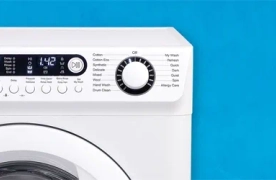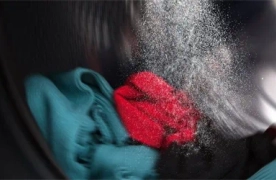5th August 2019

When experts gave their views on how we should wash our underwear, one comment left us speechless.
Chartered Environmental Health Practitioner, Dr Lisa Ackerly, told us washing at 30°C or 40°C could leave our underwear a bacteria-filled mess!
She revealed that unless we set our washing machine to a specific temperature, it won't kill the bacteria found on our undies.
She told HuffPost UK when it comes to underwear, nothing under 60 degrees will kill bacteria.
"Don't put the knickers in with the tea towels on a low wash, because you might have faecal contamination in your knickers and you wouldn't want that near your kitchen."
Well, this is some revelation if, like me, have been doing this since forever.
But it gets worse!
Immunologist Dr Jenna Macciochi said that even a 60°C wash might not be enough.
She claims, "60 degrees cannot really be relied upon to kill all bacteria, especially if the machine only reaches this temperature for a short time - most don't maintain this temperature for the entire cycle."
So, all those times we have washed our delicates at 30°C or 40°C, or chucked them in with the rest of our clothes, we haven't been cleaning them at all?
The problem is that this is a double-edged sword: making sure our underwear are faeces-free can harm the environment.
Although a less obvious contributor, our washing machine could release more than 700,000 microscopic plastic fibres into the environment each time we wash them.
Clothing made from fibres like acrylic, nylon and polyester - all of which are forms of plastic - are now about 60 per cent of the material that makes up our clothes worldwide.
Each time we wash our clothes, these fibres shed millions of microscopic plastic fibres. And these fibres - less than 5 millimetres in length - pass straight through wastewater into the ocean and in our food chain.
But what can we do?
According to environmental organisation Friends of the Earth: "turning the (washing machine) temperature down can help cut down on this pollution". This is because a lower-temperature wash is less aggressive and therefore not as prone to shed plastic fibres.
So, what now? Choose the environment or... Clean underwear?
Here at Ebac, we are among those who have recognised consumer needs that have demanded a washing machine that doesn't just clean our clothes but takes care of the environment too.
Introducing the E-Care Hot Fill Washing Machine Range.
Like a lot of the best ideas, this one is so simple that it's hard to believe it ever disappeared.
Whether it's an air or ground source heat pump, biomass heating, solar heating or other renewable heat sources - then a hot fill washing machine can be both economically and ecologically reasonable.
Unlike traditional cold fill washing machines, hot fill washing machines use existing hot water and balance it out with cold water (dependent on the temperature of the wash selected); rather than requiring electricity to heat it once it is in the machine.
Heating water in a washing machine accounts for up to 10 per cent of a household's electric bill. Regardless of the temperature of wash selected, whether a 30°C or 60°C, power is continuously needed to heat water from the mains temperature, which is around 8°C.
With promises of up to 20 per cent faster washes and up to 60 per cent cheaper running costs, maybe a hot fill washing machine is the answer to our prayers.
For those who aren't able to put their machine on a higher temperature for whatever reason, don't panic, some things can be done to keep undies faeces-free.
| Put underwear, i.e. socks, knickers and underpants, in a separate wash from bedding, clothes and towels. If something ridden with germs is put in the washing machine, unless something is done to kill the bacteria, it will be transferred around and around, especially on low-temperature washes. However we recommend washing at a temperature as high as possible - the higher the temperature, the better the germ kill. Where possible, do one wash a week above 90°C. | |
| According to Fashion Revolution, up to 25 per cent of each garment's carbon footprint comes from how we care for and wash it. And nine out of ten pieces of clothing end up in landfill long before they should because over-washing has caused irreversible colour fading, shrinkage and misshaping. Our solution? Do less washing less often. If possible, wear clothes as much as three times before washing them. However, items such as undies and socks need washing after each wear, but clothes that don't sit on our skin – such as coats and jeans – can be worn five or more times before needing a wash. |
|
| According to Cleanipedia, one of the most effective tools for eliminating germs is the sun. So, whenever the unpredictable British weather allows us to do so, hang laundry on the washing line to dry in the natural sunlight. For those of us who usually use a tumble dryer to dry laundry, there's even better news! We could save up to £90 per annum if we use a tumble dryer once a week as opposed to five times a week. So, where possible, drying laundry in the natural sunlight will not only eliminate germs but help save energy and money. |
So, with the above in mind, there is no right or wrong answer on how to wash or when to wash, but rather a risk assessment - think about it and clean it if it needs it.

17th March 2024
When choosing your new washing machine, you may already know what features you are looking for,...
Continue reading
17th March 2024
Here are some tips for choosing a quiet washing machine: Look at the decibels (dB) for washing...
Continue reading
12th March 2024
One of the things you sacrifice when buying a cheap machine is the type of functions you have...
Continue reading